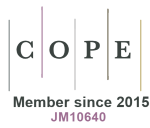Relation between interleukin-13 and annexin-V levels and carotid intima-media thickness in nephrotic syndrome
DOI:
https://doi.org/10.33393/jcb.2024.2689Keywords:
Annexin-V, Carotid intima-media thickness, Idiopathic nephrotic syndrome, Interleukin-13Abstract
Background and aim: The aim of the current study is to assess the relation between carotid intima-media thickness (CIMT) measurements, renal Doppler resistive index (RI) and serum levels of interleukin-13 (IL-13) and annexin-V (An-V) in children with idiopathic nephrotic syndrome (INS).
Materials and methods: The present case-control study was conducted on 60 children with INS and 60 age- and sex-matched healthy children. All participants were subjected to evaluation of serum levels of IL-13 and An-V and ultrasound Doppler measurement of CIMT and renal RI.
Results: Patients expressed significantly higher An-V (5.9 ± 2.6 vs. 2.1 ± 0.8 ng/mL, p<0.001) and IL-13 (19.2 ± 7.6 vs. 3.4 ± 1.4 ng/L) levels when compared with healthy counterparts. Moreover, it was shown that patients had significantly higher CIMT (0.49 ± 0.06 vs. 0.35 ± 0.03, p<0.001) as compared to controls. No significant differences were noted between the studied groups regarding right or left RIs. Correlation analysis identified significant direct correlation between serum An-V levels and albumin/creatinine ratio (ACR) (r = 0.55), cholesterol (r = 0.48), triglycerides (r = 0.36), IL-13 (r = 0.92) and CIMT (r = 0.53). Similar correlations could be found between serum IL-13 levels and CIMT measurements and the corresponding parameters.
Conclusions: The present study suggests an association between higher early atherosclerosis expressed as elevated CIMT measurements in children with INS and elevated serum levels of An-V and IL-13.
References
- Chanchlani R, Parekh RS. Ethnic differences in childhood nephrotic syndrome. Front Pediatr. 2016;4:39. PMID:27148508 https://doi.org/10.3389/fped.2016.00039 PMID:27148508 DOI: https://doi.org/10.3389/fped.2016.00039
- Wine R, Vasilevska-Ristovska J, Banh T, et al; H3 Africa Kidney Disease Research Network. Trends in the epidemiology of childhood nephrotic syndrome in Africa: a systematic review. Glob Epidemiol. 2021;3:100061. PMID:37635724 https://doi.org/10.1016/j.gloepi.2021.100061 PMID:37635724 DOI: https://doi.org/10.1016/j.gloepi.2021.100061
- Özlü SG, Demircin G, Tökmeci N, et al. Long-term prognosis of idiopathic nephrotic syndrome in children. Ren Fail. 2015;37(4):672-677. PMID:25687382 https://doi.org/10.3109/0886022X.2015.1010940 PMID:25687382 DOI: https://doi.org/10.3109/0886022X.2015.1010940
- Carter SA, Mistry S, Fitzpatrick J, et al. Prediction of short- and long-term outcomes in childhood nephrotic syndrome. Kidney Int Rep. 2019;5(4):426-434. PMID:32280840 https://doi.org/10.1016/j.ekir.2019.12.015 PMID:32280840 DOI: https://doi.org/10.1016/j.ekir.2019.12.015
- Kitsou K, Askiti V, Mitsioni A, Spoulou V. The immunopathogenesis of idiopathic nephrotic syndrome: a narrative review of the literature. Eur J Pediatr. 2022;181(4):1395-1404. https://doi.org/10.1007/s00431-021-04357-9 PMID:35098401 DOI: https://doi.org/10.1007/s00431-021-04357-9
- Guo HL, Li L, Xu ZY, et al. Steroid-resistant nephrotic syndrome in children: a mini-review on genetic mechanisms, predictive biomarkers and pharmacotherapy strategies. Curr Pharm Des. 2021;27(2):319-329. https://doi.org/10.2174/1381612826666201102104412 PMID:33138756 DOI: https://doi.org/10.2174/1381612826666201102104412
- da Silva Filha R, Burini K, Pires LG, Brant Pinheiro SV, Simões E Silva AC. Idiopathic nephrotic syndrome in pediatrics: an up-to-date. Curr Pediatr Rev. 2022;18(4):251-264. https://doi.org/10.2174/1573396318666220314142713 PMID:35289253 DOI: https://doi.org/10.2174/1573396318666220314142713
- Matera MG, Ora J, Calzetta L, Rogliani P, Cazzola M. Investigational anti IL-13 asthma treatments: a 2023 update. Expert Opin Investig Drugs. 2023;32(5):373-386. PMID:37194672 https://doi.org/10.1080/13543784.2023.2215425 PMID:37194672 DOI: https://doi.org/10.1080/13543784.2023.2215425
- Iwaszko M, Biały S, Bogunia-Kubik K. Significance of interleukin (IL)-4 and IL-13 in inflammatory arthritis. Cells. 2021;10(11):3000. PMID:34831223 https://doi.org/10.3390/cells10113000 PMID:34831223 DOI: https://doi.org/10.3390/cells10113000
- Shi J, Song X, Traub B, Luxenhofer M, Kornmann M. Involvement of IL-4, IL-13 and their receptors in pancreatic cancer. Int J Mol Sci. 2021;22(6):2998. PMID:33804263 https://doi.org/10.3390/ijms22062998 PMID:33804263 DOI: https://doi.org/10.3390/ijms22062998
- Shobeiri SS, Sankian M. Polyvinyl alcohol can stabilize FITC conjugated recombinant annexin V for apoptotic cells detection. Protein Pept Lett. 2022;29(9):806-814. https://doi.org/10.2174/0929866529666220617153809 PMID:35718962 DOI: https://doi.org/10.2174/0929866529666220617153809
- Simonsen AC, Boye TL, Nylandsted J. Annexins bend wound edges during plasma membrane repair. Curr Med Chem. 2020;27(22):3600-3610. https://doi.org/10.2174/0929867326666190121121143 PMID:30663559 DOI: https://doi.org/10.2174/0929867326666190121121143
- Horimoto AMC, de Jesus LG, de Souza AS, Rodrigues SH, Kayser C. Anti-annexin V autoantibodies and vascular abnormalities in systemic sclerosis: a longitudinal study. Adv Rheumatol. 2020;60(1):38. PMID:32736594 https://doi.org/10.1186/s42358-020-00140-w PMID:32736594 DOI: https://doi.org/10.1186/s42358-020-00140-w
- Bratseth V, Margeirsdottir HD, Chiva-Blanch G, et al. Annexin V+ microvesicles in children and adolescents with type 1 diabetes: a prospective cohort study. J Diabetes Res. 2020;2020:7216863. PMID:32309448 https://doi.org/10.1155/2020/7216863 PMID:32309448 DOI: https://doi.org/10.1155/2020/7216863
- Hu Y, Liu G, Zhang H, et al. A comparison of [99mTc]duramycin and [99mTc]annexin V in SPECT/CT imaging atherosclerotic plaques. Mol Imaging Biol. 2018;20(2):249-259. PMID:28785938 https://doi.org/10.1007/s11307-017-1111-9 PMID:28785938 DOI: https://doi.org/10.1007/s11307-017-1111-9
- Jakubowska A, Kiliś-Pstrusińska K. Annexin V in children with idiopathic nephrotic syndrome treated with cyclosporine A. Adv Clin Exp Med. 2020;29(5):603-609. https://doi.org/10.17219/acem/121519 PMID:32469166 DOI: https://doi.org/10.17219/acem/121519
- Ahmed HM, Ameen EE, Awad MS, Botrous OE. Assessment of carotid intima media thickness and left ventricular mass index in children with idiopathic nephrotic syndrome. Vasc Health Risk Manag. 2021;17:349-356. https://doi.org/10.2147/VHRM.S295868 PMID:34140775 DOI: https://doi.org/10.2147/VHRM.S295868
- Hyla-Klekot L, Bryniarski P, Pulcer B, Ziora K, Paradysz A. Dimethylarginines as risk markers of atherosclerosis and chronic kidney disease in children with nephrotic syndrome. Adv Clin Exp Med. 2015;24(2):307-314. PMID:25931365 https://doi.org/10.17219/acem/40465 PMID:25931365 DOI: https://doi.org/10.17219/acem/40465
- Vaziri ND. HDL abnormalities in nephrotic syndrome and chronic kidney disease. Nat Rev Nephrol. 2016;12(1):37-47. PMID:26568191 https://doi.org/10.1038/nrneph.2015.180 PMID:26568191 DOI: https://doi.org/10.1038/nrneph.2015.180
- Geraci G, Buccheri D, Zanoli L, et al. Renal haemodynamics and coronary atherosclerotic burden are associated in patients with hypertension and mild coronary artery disease. Exp Ther Med. 2019;17(4):3255-3263. https://doi.org/10.3892/etm.2019.7279 PMID:30906482 DOI: https://doi.org/10.3892/etm.2019.7279
- Youssef DM, Fawzy FM. Value of renal resistive index as an early marker of diabetic nephropathy in children with type-1 diabetes mellitus. Saudi J Kidney Dis Transpl. 2012;23(5):985-992. PMID:22982911 https://doi.org/10.4103/1319-2442.100880 PMID:22982911 DOI: https://doi.org/10.4103/1319-2442.100880
- Moriconi D, Mengozzi A, Duranti E, et al. The renal resistive index is associated with microvascular remodeling in patients with severe obesity. J Hypertens. 2023;41(7):1092-1099. https://doi.org/10.1097/HJH.0000000000003434 PMID:37071436 DOI: https://doi.org/10.1097/HJH.0000000000003434
- Ghafori M, Rashedi A, Montazeri M, Amirkhanlou S. The relationship between Renal Arterial Resistive Index (RRI) and renal outcomes in patients with resistant hypertension. Iran J Kidney Dis. 2020;14(6):448-453. PMID:33277448 PMID:33277448
- Provenzano M, Rivoli L, Garofalo C, et al. Renal resistive index in chronic kidney disease patients: possible determinants and risk profile. PLoS One. 2020;15(4):e0230020. https://doi.org/10.1371/journal.pone.0230020 PMID:32236125 DOI: https://doi.org/10.1371/journal.pone.0230020
- Primary nephrotic syndrome in children: clinical significance of histopathologic variants of minimal change and of diffuse mesangial hypercellularity. A report of the International Study of Kidney Disease in Children. Kidney Int. 1981;20(6):765-771. https://doi.org/10.1038/ki.1981.209 PMID:7334749 DOI: https://doi.org/10.1038/ki.1981.209
- Trautmann A, Vivarelli M, Samuel S, et al; International Pediatric Nephrology Association. IPNA clinical practice recommendations for the diagnosis and management of children with steroid-resistant nephrotic syndrome. Pediatr Nephrol. 2020;35(8):1529-1561. https://doi.org/10.1007/s00467-020-04519-1 PMID:32382828 DOI: https://doi.org/10.1007/s00467-020-04519-1
- Flynn JT, Kaelber DC, Baker-Smith CM, et al; SUBCOMMITTEE ON SCREENING AND MANAGEMENT OF HIGH BLOOD PRESSURE IN CHILDREN. Clinical practice guideline for screening and management of high blood pressure in children and adolescents. Pediatrics. 2017;140(3):e20171904. https://doi.org/10.1542/peds.2017-1904 PMID:28827377 DOI: https://doi.org/10.1542/peds.2017-3035
- Hooman N, Isa-Tafreshi R, Otukesh H, Mostafavi SH, Hallaji F. Carotid artery function in children with idiopathic nephrotic syndrome. Nefrologia. 2013;33(5):650-656. https://doi.org/10.3265/Nefrologia.pre2013.May.12036 PMID:24089156
- Youssef DM, Gomaa MA, El-Akhras A, et al. Brachial artery flow-mediated dilatation and carotid intima-media thickness in children with idiopathic nephrotic syndrome. Iran J Kidney Dis. 2018;12(6):331-340. PMID:30595562 PMID:30595562
- Skrzypczyk P, Kuźma-Mroczkowska E, Kułagowska J, Brzewski M, Okarska-Napierała M, Pańczyk-Tomaszewska M. Carotid intima-media thickness in children with idiopathic nephrotic syndrome: a single center cross-sectional study. Clin Nephrol. 2019;91(6):353-362. https://doi.org/10.5414/CN109617 PMID:31079597 DOI: https://doi.org/10.5414/CN109617
- Paripović A, Stajić N, Putnik J, Gazikalović A, Bogdanović R, Vladislav V. Evaluation of carotid intima media thickness in children with idiopathic nephrotic syndrome. Nephrol Ther. 2020;16(7):420-423. https://doi.org/10.1016/j.nephro.2020.09.004 PMID:33162364 DOI: https://doi.org/10.1016/j.nephro.2020.09.004
- Kamel AS, AlGhawass MME, Sayed MA, Roby SA. Evaluation of carotid intima media thickness in children with idiopathic nephrotic syndrome. Ital J Pediatr. 2022;48(1):195. https://doi.org/10.1186/s13052-022-01383-7 PMID:36494853 DOI: https://doi.org/10.1186/s13052-022-01383-7
- Kniazewska MH, Obuchowicz AK, Wielkoszyński T, et al. Atherosclerosis risk factors in young patients formerly treated for idiopathic nephrotic syndrome. Pediatr Nephrol. 2009;24(3):549-554. https://doi.org/10.1007/s00467-008-1029-1 PMID:18972136 DOI: https://doi.org/10.1007/s00467-008-1029-1
- Rahul I, Krishnamurthy S, Satheesh S, Biswal N, Bobby Z, Lakshminarayanan S. Brachial artery flow-mediated dilatation and carotid intima medial thickness in pediatric nephrotic syndrome: a cross-sectional case-control study. Clin Exp Nephrol. 2015;19(1):125-132. https://doi.org/10.1007/s10157-014-0958-1 PMID:24639030 DOI: https://doi.org/10.1007/s10157-014-0958-1
- Simsek B, Buyukcelik M, Soran M, et al. Urinary annexin V in children with nephrotic syndrome: a new prognostic marker? Pediatr Nephrol. 2008;23(1):79-82. https://doi.org/10.1007/s00467-007-0606-z PMID:17999093 DOI: https://doi.org/10.1007/s00467-007-0606-z
- Ye Q, Zhang Y, Zhuang J, et al. The important roles and molecular mechanisms of annexin A2 autoantibody in children with nephrotic syndrome. Ann Transl Med. 2021;9(18):1452. https://doi.org/10.21037/atm-21-3988 PMID:34734004 DOI: https://doi.org/10.21037/atm-21-3988
- Bilgir O, Vural HA, Bilgir F, Akan OY, Demir I. Serum annexin V and anti-annexin V levels and their relationship with metabolic parameters in patients with type 2 diabetes. Rev Assoc Med Bras (1992). 2019 Sep 12;65(8):1042-1047. doi: 10.1590/1806-9282.65.8.1042. DOI: https://doi.org/10.1590/1806-9282.65.8.1042
- Lai KW, Wei CL, Tan LK, et al. Overexpression of interleukin-13 induces minimal-change-like nephropathy in rats. J Am Soc Nephrol. 2007;18(5):1476-1485. https://doi.org/10.1681/ASN.2006070710 PMID:17429054 DOI: https://doi.org/10.1681/ASN.2006070710
- Kimata H, Fujimoto M, Furusho K. Involvement of interleukin (IL)-13, but not IL-4, in spontaneous IgE and IgG4 production in nephrotic syndrome. Eur J Immunol. 1995;25(6):1497-1501. https://doi.org/10.1002/eji.1830250604 PMID:7614976 DOI: https://doi.org/10.1002/eji.1830250604
- Low LD, Lu L, Chan CY, et al. IL-13-driven alterations in hepatic cholesterol handling contributes to hypercholesterolemia in a rat model of minimal change disease. Clin Sci (Lond). 2020;134(2):225-237. https://doi.org/10.1042/CS20190961 PMID:31934720 DOI: https://doi.org/10.1042/CS20190961
- Le Floc’h A, Allinne J, Nagashima K, et al. Dual blockade of IL-4 and IL-13 with dupilumab, an IL-4Rα antibody, is required to broadly inhibit type 2 inflammation. Allergy. 2020;75(5):1188-1204. PMID:31838750 https://doi.org/10.1111/all.14151 PMID:31838750 DOI: https://doi.org/10.1111/all.14151
- Pelaia C, Pelaia G, Crimi C, et al. Biological therapy of severe asthma with dupilumab, a dual receptor antagonist of interleukins 4 and 13. Vaccines (Basel). 2022;10(6):974. PMID:35746582 https://doi.org/10.3390/vaccines10060974 PMID:35746582 DOI: https://doi.org/10.3390/vaccines10060974
- Kariyawasam HH. Chronic rhinosinusitis with nasal polyps: mechanistic insights from targeting IL-4 and IL-13 via IL-4Rα inhibition with dupilumab. Expert Rev Clin Immunol. 2020;16(12):1115-1125. PMID:33148074 https://doi.org/10.1080/1744666X.2021.1847083 PMID:33148074 DOI: https://doi.org/10.1080/1744666X.2021.1847083
- Gulleroglu K, Yazar B, Sakalli H, Ozdemir H, Baskin E. Clinical importance of mean platelet volume in children with nephrotic syndrome. Ren Fail. 2014;36(5):663-665. https://doi.org/10.3109/0886022X.2014.883931 PMID:24512186 DOI: https://doi.org/10.3109/0886022X.2014.883931










